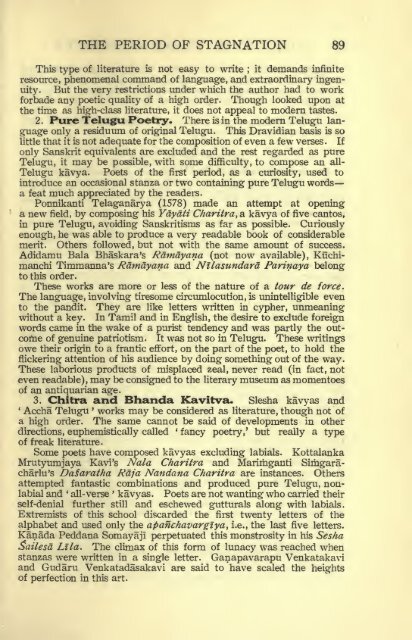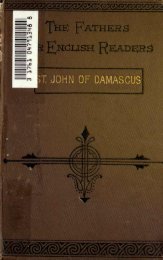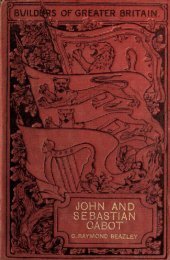A history of Telugu literature; - Cristo Raul
A history of Telugu literature; - Cristo Raul
A history of Telugu literature; - Cristo Raul
You also want an ePaper? Increase the reach of your titles
YUMPU automatically turns print PDFs into web optimized ePapers that Google loves.
THE PERIOD OF STAGNATION 89<br />
This type <strong>of</strong> <strong>literature</strong> is not easy to write ; it demands infinite<br />
resource, phenomenal command <strong>of</strong> language, and extraordinary ingenuity.<br />
But the very restrictions under which the author had to work<br />
forbade any poetic quality <strong>of</strong> a high order. Though looked upon at<br />
the time as high-class <strong>literature</strong>, it does not appeal to modern tastes.<br />
2. Pure <strong>Telugu</strong> Poetry. There is in the modern <strong>Telugu</strong> language<br />
only a residuum <strong>of</strong> original <strong>Telugu</strong>. This Dravidian basis is so<br />
little that it is not adequate for the composition <strong>of</strong> even a few verses. If<br />
only Sanskrit equivalents are excluded and the rest regarded as pure<br />
an all-<br />
<strong>Telugu</strong>, it may be possible, with some difficulty, to compose<br />
<strong>Telugu</strong> kavya. Poets <strong>of</strong> the first period, as a curiosity, used to<br />
introduce an occasional stanza or two containing pure <strong>Telugu</strong> words<br />
a feat much appreciated by the readers.<br />
Ponnikanti Telaganarya (1578) made an attempt at opening<br />
a new field, by composing his Yayati Charitra, a kavya <strong>of</strong> five cantos,<br />
in pure <strong>Telugu</strong>, avoiding Sanskritisms as far as possible. Curiously<br />
enough, he was able to produce a very readable book <strong>of</strong> considerable<br />
merit. Others followed, but not with the same amount <strong>of</strong> success.<br />
Adidamu Bala Bhaskara's Ramayana (not now available), Kuchimanchi<br />
Timmanna's Ramayana and Nllasundara Parinaya belong<br />
to this order.<br />
These works are more or less <strong>of</strong> the nature <strong>of</strong> a tour de force.<br />
The language, involving tiresome circumlocution, is unintelligible even<br />
to the pandit. They are like letters written in cypher, unmeaning<br />
without a key. In Tamil and in English, the desire to exclude foreign<br />
words came in the wake <strong>of</strong> a purist tendency and was partly the outcome<br />
<strong>of</strong> genuine patriotism. It was not so in <strong>Telugu</strong>. These writings<br />
owe their origin to a frantic effort, on the part <strong>of</strong> the poet, to hold the<br />
flickering attention <strong>of</strong> his audience by doing something out <strong>of</strong> the way.<br />
These laborious products <strong>of</strong> misplaced zeal, never read (in fact, not<br />
even readable), may be consigned to the literary museum as momentoes<br />
<strong>of</strong> an antiquarian age.<br />
3. Chitra and Bhanda Kavitva. Slesha kavyas and<br />
' Accha <strong>Telugu</strong> ' works may be considered as <strong>literature</strong>, though not <strong>of</strong><br />
a high order. The same cannot be said <strong>of</strong> developments in other<br />
called '<br />
directions, euphemistically fancy poetry,' but really a <strong>of</strong> freak <strong>literature</strong>.<br />
type<br />
Some poets have composed kavyas excluding labials. Kottalanka<br />
Mrutyumjaya Kavi's Nala Charitra and Marimganti Simgaracharlu's<br />
Dasaratha Raja Nandana Charitra are instances. Others<br />
attempted fantastic combinations and produced pure <strong>Telugu</strong>, nonlabial<br />
and '<br />
all- verse '<br />
kavyas. Poets are not wanting who carried their<br />
self-denial further still and eschewed gutturals along with labials.<br />
Extremists <strong>of</strong> this school discarded the first twenty letters <strong>of</strong> the<br />
alphabet and used only the apanchavargiya, i.e., the last five letters.<br />
Kanada Peddana Somayaji perpetuated this monstrosity in his Sesha<br />
Sailesa Llla. The climax <strong>of</strong> this form <strong>of</strong> lunacy was reached when<br />
stanzas were written in a single letter. Ganapavarapu Venkatakavi<br />
and Gudaru Venkatadasakavi are said to have scaled the heights<br />
<strong>of</strong> perfection in this art.

















